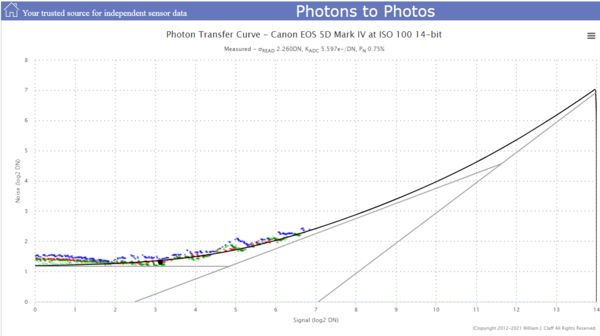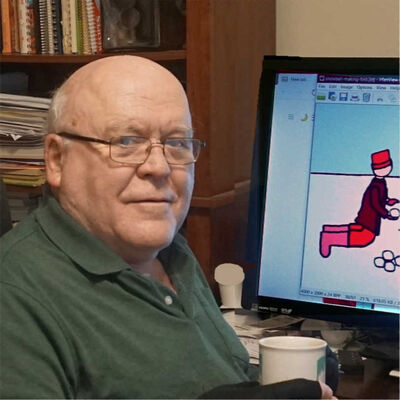Why does cropping reduce dynamic range?
Feb 26, 2021 16:44:07 #
Canisdirus wrote:
It all stems from the pixels...the very first thin... (show quote)
It’s exactly the same luminance per sq mm and the same photosites and pixel density. It’s not black magic at the sensor level that decreases the DR - you only lose DR IF you expand the image to the same size as the FF.
The actual (very simple) reason was provided on page 3 along with a link to a paper providing details, by the person that runs the site in question and wrote the algorithm that produces the data in question. The next 6 pages (and counting) are just arguments with a very occasional actual question.
Feb 26, 2021 16:57:52 #
Drbobcameraguy wrote:
Excellent way to explain it. (Referring to one of Ysarex's comments.)
A substantial part of our disagreement with each other on this thread is that we have not stated what we are holding constant.
For example, when talking about comparing a full-size sensor and a cropped sensor, the adage that the more light received by the sensor, the less noise there will be. This is true ONLY if one uses the same sensor. In fact, from this scenario, one can infer the correct rule: Each pixel on a given sensor will under normal conditions keep the same level of noise and thus the more light received by a pixel the more the signal-to-noise ratio will increase.
Thus since we really need to look at the characteristics of each pixel on the sensor to evaluate the sensor's dynamic range, we see that (unless we are moving to the extremes in light levels) noice does not have a major effect on dynamic range. I am not sure how or what William J. Claff is actually measuring on his web site, "Photons to Photons," when he is talking about dynamic range, but the conclusions seem incorrect to me.
Also, comparing a full-size sensor output printed on an 8 X 10 paper to a half-size sensor print-out printed also to an 8 X 10 paper, is not good for comparing dynamic range or other pixel-centered characteristics.
Just some thoughts. --Richard
Feb 26, 2021 17:06:46 #
profbowman wrote:
A substantial part of our disagreement with each o... (show quote)
I’ll let Bill respond to you, but the fact is that DR and SNR ARE determined by noise (and the resolution and accuracy of the digitizer for digital signals), with any type of received electromagnetic signals - its’s typically THE determining factor. Noise determines the DR/SNR of received/measured Audio, electrical, radio signals and light. You only have to play an old LP or listen to a radio signal to experience that.
Feb 26, 2021 17:15:03 #
bclaff
Loc: Sherborn, MA (18mi SW of Boston)
profbowman wrote:
It would have been better if your sentence had ended here.... I am not sure how or what William J. Claff is actually measuring on his web site, "Photons to Photons," when he is talking about dynamic range,
profbowman wrote:
but the conclusions seem incorrect to me.
Because your not understanding is why you come to a wrong conclusion.
profbowman wrote:
It is the perfect comparison if you are a photographer who is ultimately creating an 8 x 10 image and you want to compare how different sensors will perform.Also, comparing a full-size sensor output printed on an 8 X 10 paper to a half-size sensor print-out printed also to an 8 X 10 paper, is not good for comparing dynamic range or other pixel-centered characteristics.
There are other measures at PhotonsToPhotos that are at the pixel level independent of sensor size.
FWIW, the original post clearly refers to the Photographic Dynamic Range (PDR) measure at PhotonsToPhotos.
PDR is documented there so your ignorance seems willful (to me).
Respectfully,
Feb 26, 2021 17:31:48 #
bclaff
Loc: Sherborn, MA (18mi SW of Boston)
TriX wrote:
The distinction I was making earlier is that DxOMark Landscape DR is based solely on read noise whereas PhotonsToPhotos PDR uses a Signal to Noise Ratio (SNR) where noise is all forms of noise not just read noise (for example photon (shot) noise).I’ll let Bill respond to you, but the fact is that DR and SNR ARE determined by noise (and the resolution and accuracy of the digitizer for digital signals), with any type of received electromagnetic signals - its’s typically THE determining factor. Noise determines the DR/SNR of received/measured Audio, electrical, radio signals and light. You only have to play an old LP or listen to a radio signal to experience that.
Feb 26, 2021 17:48:09 #
Ysarex
Loc: St. Louis
bclaff wrote:
The distinction I was making earlier is that DxOMark Landscape DR is based solely on read noise whereas PhotonsToPhotos PDR uses a Signal to Noise Ratio (SNR) where noise is all forms of noise not just read noise (for example photon (shot) noise).
And while the opportunity presents I'd like to take a quick moment to say Thank You Bill! Since I found your work years ago I've come to rely on it as the most valuable and most real in-the-field accurate data available.

Feb 26, 2021 18:30:16 #
bclaff wrote:
The distinction I was making earlier is that DxOMark Landscape DR is based solely on read noise whereas PhotonsToPhotos PDR uses a Signal to Noise Ratio (SNR) where noise is all forms of noise not just read noise (for example photon (shot) noise).
Yes - I read your document. Question: since shot noise is reduced and SNR increases as a larger number of Photons strike a photosite, does a larger number of photosites reduce shot noise by essentially averaging out the random occurrences, and if so, is it a significant contributor to total noise compared to read noise?
Feb 26, 2021 18:33:03 #
Ysarex wrote:
And while the opportunity presents I'd like to take a quick moment to say Thank You Bill! Since I found your work years ago I've come to rely on it as the most valuable and most real in-the-field accurate data available. 

👍👍 I second that. i’ve referred to and reposted Photons to Photos data literally many dozens of times over the years I’ve participated in the forum. Much appreciated!
Feb 26, 2021 18:36:38 #
profbowman wrote:
A substantial part of our disagreement with each o... (show quote)
My take from the discussion is that noise is the main thing that is defining the floor of the dynamic range. If detail is there in the shadows but indistinguishable from noise, then detail is not really there, so here is the bottom of the dynamic range measurement.
Feb 26, 2021 18:38:30 #
Ysarex wrote:
And while the opportunity presents I'd like to take a quick moment to say Thank You Bill! Since I found your work years ago I've come to rely on it as the most valuable and most real in-the-field accurate data available. 

+1 to the big thank you!
Feb 26, 2021 19:04:19 #
bclaff
Loc: Sherborn, MA (18mi SW of Boston)
TriX wrote:
Definitely yes for a measure like Photographic Dynamic Range (PDR).Yes - I read your document. Question: since shot noise is reduced and SNR increases as a larger number of Photons strike a photosite, does a larger number of photosites reduce shot noise by essentially averaging out the random occurrences, and if so, is it a significant contributor to total noise compared to read noise?
Think of it this way, noise becomes acceptable when the signal rises far enough to mask the noise. That signal carries photon noise with it, even if it's a small amount. You can see this on the Photon Transfer Curves (PTCs) at PhotonsToPhotos. See the attached example. The black dot marks PDR. Read noise alone would be about 2 stop to the left.

Feb 26, 2021 20:31:47 #
bclaff wrote:
Definitely yes for a measure like Photographic Dyn... (show quote)
That plot is reminiscent of the toe portion of a typical film curve where the goal is to pick a point where the signal emerges from the confusion of film base+fog (FB+fog). Kodak used it to define film speed (a log density of about 0.1 over FB+fog).
The solution was to print anything at or below FB+fog as pure black. Fred Picker used it to define a proper proof in the darkroom.
A similar approach with digital is to set the black point high enough to eliminate all of the really annoying noise. That's not always a bad thing. Pure black is usually better than muddy shadows.
Feb 26, 2021 23:57:38 #
larryepage
Loc: North Texas area
This has ended up being quite an interesting discussion. I think what has been most worthy of note for me, though, is the amount of energy that gets spent discussing things that, while intetesting, have little or no real-world significance because in reality the differences are too small to have a meaningful effect in real life.
I am making a resolution to devote less time to these discussions and more time to discussions with the three art teachers who I am so fortunate to have as friends. They are both kinder and cuter than just about everyone here, and we are all interested in helping each other be better at what we do. Our current projects include lighting and scope vs. scale (read that as most effectively using ultra-wide-angle lenses).
See you folks later.
I am making a resolution to devote less time to these discussions and more time to discussions with the three art teachers who I am so fortunate to have as friends. They are both kinder and cuter than just about everyone here, and we are all interested in helping each other be better at what we do. Our current projects include lighting and scope vs. scale (read that as most effectively using ultra-wide-angle lenses).
See you folks later.
Feb 27, 2021 07:16:13 #
TriX wrote:
It’s exactly the same luminance per sq mm and the ... (show quote)
Well, you have less light (less pixels to work with).
Feb 27, 2021 07:30:14 #
Ysarex wrote:
Noise increases because of the different total are... (show quote)
Congrats, Ysarex!
An admirable demo elegant in its simplicity and concision of explanation!
If you want to reply, then register here. Registration is free and your account is created instantly, so you can post right away.




